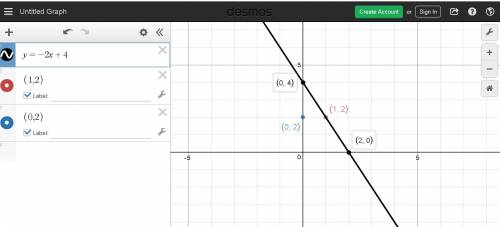Mark me as brain list
Step-by-step explanation:
correct answer would be: B = –2x – 8y = 8
There
Mark me as brain list
Step-by-step explanation:
correct answer would be: B = –2x – 8y = 8
There
 7
7 we have
 ---------> equation
---------> equation 
using a graph tool
see the attached figure
Statements
A The graph of the equation is the set of all points on the coordinate plane
This statement is False
Because
The graph of the equation is the set of points that are solutions to the equation
B. The point (1, 2) lies on the graph of the equation
This statement is True
see the attached figure
Verify
For  find the value of y in the equation
find the value of y in the equation  and compare with the y-coordinate of the point
and compare with the y-coordinate of the point
so

 --------> the point lies on the graph
--------> the point lies on the graph
C. The graph of the equation is the set of points that are solutions to the equation
This statement is true
All ordered pairs (x,y) that satisfy  are solutions of the equation
are solutions of the equation
D.The point (0, 2) lies on the graph of the equation
This statement is false
see the attached figure
Verify
For  find the value of y in the equation
find the value of y in the equation  and compare with the y-coordinate of the point
and compare with the y-coordinate of the point
so

 --------> the point not lies on the graph
--------> the point not lies on the graph

 7
7 we have
 ---------> equation
---------> equation 
using a graph tool
see the attached figure
Statements
A The graph of the equation is the set of all points on the coordinate plane
This statement is False
Because
The graph of the equation is the set of points that are solutions to the equation
B. The point (1, 2) lies on the graph of the equation
This statement is True
see the attached figure
Verify
For  find the value of y in the equation
find the value of y in the equation  and compare with the y-coordinate of the point
and compare with the y-coordinate of the point
so

 --------> the point lies on the graph
--------> the point lies on the graph
C. The graph of the equation is the set of points that are solutions to the equation
This statement is true
All ordered pairs (x,y) that satisfy  are solutions of the equation
are solutions of the equation
D.The point (0, 2) lies on the graph of the equation
This statement is false
see the attached figure
Verify
For  find the value of y in the equation
find the value of y in the equation  and compare with the y-coordinate of the point
and compare with the y-coordinate of the point
so

 --------> the point not lies on the graph
--------> the point not lies on the graph

 10
10  28
28  10
10  28
28  4
4  6
6 Step-by-step explanation:
The given equations are

Notice that all given equations have a negative quadratic term.
Remember that the form of a quadratic equation is

Where  is the coefficient of the quadratic term.
is the coefficient of the quadratic term.
When  , the parabola that represents the equation opens downward, because the quadratic term is negative.
, the parabola that represents the equation opens downward, because the quadratic term is negative.
Therefore, in this case, the common charactersitc between all equations is that they all represent a parabola which opens downward.
However, there's another characteristic. All parabolas are symmetrical about the y-axis, because the square power has only x-variable inside.
Therefore, the right answer is D.

It will provide an instant answer!
